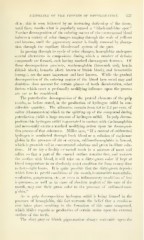Page 539 - My FlipBook
P. 539
RATIONALE OF THE PROCESS OF DISCOLORATION. 537
skin ; tliis is soon followed by an increasing darkening of the tissue,
until there results what is popularly termed a " black-and-blue spot,"
Further decomposition of the coloring matter of the extravasated blood
induces a variety of color changes ranging through the scale of yellows
and browns, until the pigmentary matter is finally removed by absorp-
tion through the capillary bloodvessel system of the part.
In passing through its cycle of color changes, hemoglobin undergoes
several alterations in composition during which a number of definite
compounds are formed, each having marked chromogenic features. Of
these decomposition products, methemoglobin (brownish red), hemin
(bluish black), hematin (dark brown or bluish black), and hematoidin
(orange), are the most important and best know^n. While the gradual
decomposition of the coloring matter of the blood here noted may and
are yet to be considered.
The putrefactive decomposition of the proteid elements of the pulp
results, as before stated, in the production of hydrogen sulfid in con-
siderable quantity. The albumins contain from 0,8 to 2,2 per cent, of
sulfur (Hammarsten) which in the splitting up of the compound during
putrefaction yields a large amount of hydrogen sulfid. In pulp decom-
position this hydrogen sulfid is generated in contact with the hemoglobin
and necessarily exerts a marked modifying action upon the decomposi-
tion process of that substance. Miller says, " If a current of sulfuretted
hydrogen is conducted through fresh blood or a solution of oxyhemo-
globin in the presence of air or oxygen, sulfomethemoglobin is formed,
which is greenish red in concentrated solutions and green in dilute solu-
tions. If we lay a freshly extracted tooth in a mixture of meat and
saliva so that a part of the enamel surface remains free, and moisten
the surface with blood, it will take on a dirty-green color if kept at
blood temperature in an absolutely moist condition for from twenty-four
to forty-eight hours. It is quite possible that the dirty-green deposits
which form in putrid conditions of the mouth, in stomatitis mercurialis,
S(!orbutica, gangrenosa, etc, or even in inflammatory conditions of less
importance, as well as in cases of absolute neglect of the care of the
mouth, may owe their green color to the presence of sulfomethemo-
globin,"
As in pulp decomposition hydrogen sulfid is being formed in the
presence of hemoglobin, this llict warrants the belief that a combina-
tion takes place resulting in the formation of this same compound,
which Miller regards as ])rodu('tive of certain stains upon the external
surface of the teeth.
The slaty gray or bluisii [)igni('ntati()n always noticeable uj)on the


